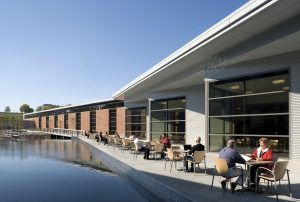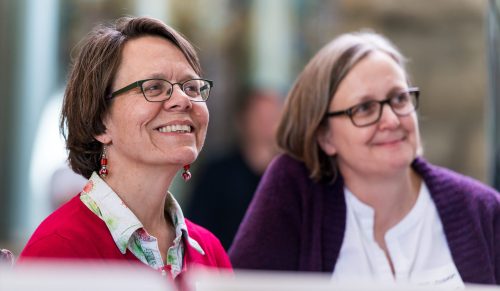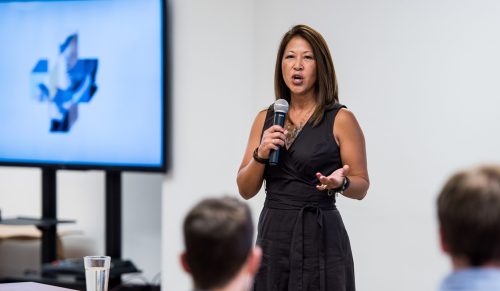
Part 2 | Women in Design: Pillars of BNIM’s Legacy – Barb Cugno
This March, in celebration of Women’s History Month and 50 years as a practice, we are reflecting on legacy here at BNIM. The journey of our practice – the projects, discoveries, movements, and milestones — is a journey shaped by the passionate, dedicated team of professionals and practitioners who have helped build, guide, and inspire the firm. Among these impactful BNIMers is a group of individuals who, together, represent a long history of pioneering change at BNIM and in the industry. As true innovators, advocates of sustainable practice and policy, and leaders of our firm, BNIM’s women in design are pillars of the firm’s legacy.
We had the opportunity to sit down with several of our female leaders at BNIM who have each shaped the firm through their respective practice and leadership over the last three decades. From Maria’s pioneering work in business development and communication in the AEC industry, to Barb leading the way for females in the architectural practice, to Sarah advancing the continually evolving area of sustainability within architectural specifications, to Laura advocating for global sustainability and resilience from the beginning of the movement in the 1990s — our interviewees have long been at the forefront of innovation in practice, and each continues to shape new paths forward. We are excited to share a series of interviews with BNIMers Maria, Barb, Sarah, and Laura.
Barb Cugno, IIDA, AIA LEED AP – 30 years at BNIM
“I think we are the real deal with sustainability…It’s in our nature. We almost don’t have to be aware of it to do it. It’s just what we do. It’s in our bones.”
BARB CUGNO, IIDA
Barb Cugno is a dedicated Project Architect and Interior Designer of 30 years at BNIM. Throughout her career, Barb’s work has contributed to BNIM’s core purpose of delivering “beautiful, integrated living environments that inspire change and enhance the human condition.” With her extensive experience and versatility, Barb’s work spans a variety of projects at BNIM, from the School of Nursing and Student Community Center at UTHSC-Houston to Crossroads Academy Elementary School to KCI Parking Garage to the University of Missouri School of Music. Barb brings a thoughtful approach to these projects through the creation of healthy spaces where people work and interact on a daily basis.
Q: What initially drew you to working with BNIM?
A// “I came to BNIM in 1985, and at the time, I was looking for a firm that had a good reputation in town. I was moving from out of town, and I knew of David Immenschuh and that he was a really good interior architect. I interviewed with several firms, but this was the one that drew me. Speaking with David during my interview, he was very passionate about the firm and the firm’s future.”
Q: This is BNIM’s 50th year as a practice. What is your view of the history and legacy of BNIM? What does 50 years mean to you?
A// “Any firm that can last 50 years would have a large legacy behind them. The firm has changed culturally throughout the last 50 years. I have only seen 30 of them, but [the firm] changed significantly with technology. It changed significantly with the realization of sustainability and how important that was, how we can draw it into our practice, and how you can make good design with less… good design with sustainability.”

INTERNAL REVENUE SERVICE KANSAS CITY CAMPUS
Q: How have you seen the industry change during your time at BNIM?
A// “Everybody is aware of sustainability…I think that we are the real deal with sustainability, obviously since the nation recognizes us as a leader in sustainability. Not all firms or products that label themselves as sustainable are. It’s in our nature. We almost don’t have to be aware of it to do it. It’s just what we do. It’s in our bones.”
Q: What do you enjoy most about working alongside your fellow Women in Design?
A// “All of them are very excellent and creative. There are no egos.
In the last 30 years, there’s been almost an explosion of women entering the profession. When I was in school, there was maybe four or five other women, whereas now I read somewhere that about 50 percent of the architecture students are women. It’s stuck with me; that is phenomenal.
When I was in college, I went to an art store in my hometown to get some supplies. I was talking to the salesclerk, and when she found out I was in architecture, she said, ‘Well, what do women do in architecture? The same thing guys do?’ It was a male-dominated profession, and I had one fellow student in one of my studio classes tell me that women didn’t belong in architecture. So, when you tell me something like that, I say, ‘I’m going to do it.’
It really has become friendlier as the years have gone on, and people recognize that women bring a lot to the table.”
Q: We talk a lot about Human-Purposed Integrated Design as an integral part of BNIM’s approach to design. In your work creating spaces that people interact in and work in everyday, what are some key elements you focus on to create environments where people thrive?
A// “Well each project is different, but they all need natural light, which is healthier. They need more materials that will not hurt them in terms of what can seep out of them or what is toxic in them. So, we pay a lot of attention to materials selection. We have several people who are good mentors in terms of helping you achieve energy goals, and that’s beneficial to the client.”

